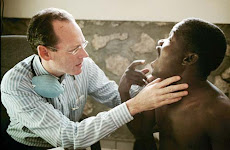Lab 1: Diffusion & OsmosisPart 1: Diffusion - Will starch or iodine move through the semi permeable membrane?
Procedure: In a beaker place a dialysis bag filled with starch. Then add iodine to the beaker. Wait for 20 minutes and observe a color change at the end.
Results: Water in dialysis bag turns black
Conclusion: The iodine is small enough to move through the permeable membrane but the starch is unable to move through the membrane
Part 2: Osmosis - Which bag will show the greatest change in mass?
Procedure: Set up six beakers with dialysis bags that contain different concentrations of sucrose - place the bags in water. Mass the bags day 1 and 24 hours later. Record and find % change in mass.
Results: The bag with the most sugar will show the greatest change in mass
Part 3: Osmosis: Which concentration of sugar most resembles the potato?
Procedure: Set up six beakers with six different concentrations of sucrose. Place a potato in each beaker. Record mass of potato on day 1 and day 2. Find % change in mass.
Results: Make a graph of % change of mass on the Y axis and Concentration of sucrose on the X axis. Make a best fit line and the place where the line crosses the X axis at zero is equal to the concentration of the potato.
Lab 2: Enzymes
Part 1: Does heat affect enzymes?
Procedure: Hydrogen peroxide -> gets broken down in the liver to water and oxygen
This is done very quickly with an enzyme. Hydrogen peroxide is a poison and must be disposed of. In this part of the lab we took a piece of liver which contains enzymes and placed it in hydrogen peroxide. We also put a piece of liver that had been boiled into hydrogen peroxide.
Results: The beaker with liver and hydrogen peroxide boiled showing water and oxygen was being made. The beaker with cooked liver did not boil showing enzyme had been boiled.
Part 2: Will the reaction above occur without an enzyme?
Procedure: leave a beaker with just hydrogen peroxide out over night containing 10 ml. The next day measure the amount of hydrogen peroxide using a titration of potassium permagnate. The amount of potassium permagnate used is equal to hydrogen peroxide left. The solution turns pink when it is equal.
Part 3: Does the concentration of enzyme affect the rate of the reaction?
Set up six beakers and add hydrogen peroxide to each beaker. Add your catalysis and then add sulfuric acid at different intervals for each beaker. The sulfuric acid stops the reaction. After stopping the reaction titrate the samples to find out how much hydrogen peroxide was left.
Results: The initial rate is high and then levels off at a certain point. The higher the concentration of enzyme in general the faster the rate up until a point.
jamie is really awesomeLab 3: Mitosis & Meiosis
Part 1: Observe the phases of mitosis
(Interphase - before Mitosis) Prophase, Metaphase, Anaphase, Telophase, (Cytokinesis - after)
Part 2: Compare Mitosis and Meiosis
Mitosis - produces identical cells (diploid), occurs only in somatic cells, 1 phase of mitosis
Meiosis - produces different cells (haploid), occurs only in sex cells, crossing over occurs, 2 phases
Part 3: Calculate Map Units
# of cross overs/total # of chromosomes = x 100/2
Lab 4: Plant Pigments & Photosynthesis
Part 1: Chromotography - separates pigments
Rf = distance pigments moved/distance solvent moved
Pigment that travels the least - chlorophyll a and b
Pigment that is in the middle - orange - xanthophyll
Pigment that travels the farthest - yellow - beta carotene
Part 2: Does light influence rate of photosynthesis?
Procedure: Take a vial with chlorophyll and place it in the light and another one in the dark
Take a vial with boiled chlorophyll and place one in the light and one in the dark.
Add DPIP to each vial - DPIP is blue and turns clear when it is oxidized in the process of photosynthesis.
Use a spectrophotometer to measure the amount of light each emits. The more photosynthesis that the chlorophyll participates in the more clear the vial or the higher the rate of transmittance.
Results: The boiled chlorophlyll did not have results. The chlorophyll in the light showed an increase in light transmittance.
Lab 5 Cellular Respiration
Objective: Measure the rate of cellular respiration in germinating and nongerminating peas.
Procedure: Take a vial and place cotton balls at the bottom and KOH. The KOH will absorb any CO2 produced during cellular respiration. Above the cotton balls place your seeds (you need six vials - one for germinating seeds at room temperature, one for germinating at warm temperature, one for nongerminating at room temperature, one for nongerminating at warm termperature, and two with beads at each temperature. The beads are the control. Place a pipette through a stopper and put the pipette at the end of the vial. Place the vial under water and add some food coloring. Over time record the amount of water that enters the pipette. The more water that enters the pipette the more oxygen has been used in respiration.
Results: The peas at warm temperature and germinating used the most oxygen, followed by germinating at room temperature
Lab 6: Molecular Genetics
Part 1: Transformation: We will insert a gene using a plasmid to make bacteria resistant to antibiotics
Procedure: Get four petri dishes - 2 with agar, 2 with agar and antibiotics - obtain a bacteria and mix the plasmid in a solution with bacteria. Place bacteria with no plasmid on each type of plate, place bacteria with plasmid on each type of plate. Count the number of bacteria that grow on day 2
Results: Plates with agar and bacteria with and without bacteria show lawns - bacteria grow everywhere. Plates with antibiotics and bacteria with no plasmid show no growth - plates with antibiotics and bacteria with plasmid show a little bit of growth - few colonies
Part 2: Gel Electrophoresis - use restriction enzymes to cut DNA into fragments.
Procedure: Obtain DNA and cut with two restriction enzymes, HIND III and ECORI. Load DNA into a gel and observe the number of bands that are formed.
Factors the affect the rate of movement:
1. Size of the Fragment
2. Current - amount of electricity
3. Concentration of Agar
This technique is used for:
1. Forensics
2. Paternity
3. Comparative DNA - evolution








